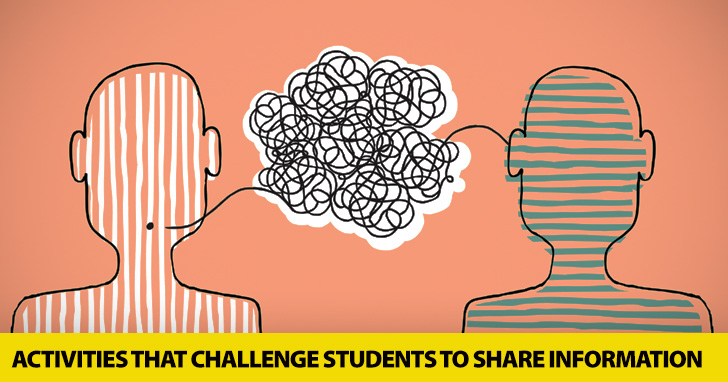All for One and One for All: 4 Super Easy Steps to Improving Your Studentsí Oral Communication


They will use what they know to communicate their thoughts and ideas to other speakers of English. It may be in a business setting, an academic setting, or a fun setting. Where the communication happens doesn't matter. What does matter is that your students are able to share their ideas with the people around them.
You can design them around whatever you are currently studying or just use them as is. Either way your students will be using the language they know to communicate ideas to their classmates, preparing them for their future language challenges.The following activities are simple, everyday activities that you can use in class to give students practice communicating information to each other.

Have you every played that old fashioned game called telephone? In it, one person whispers something to the student next to him or her who in turn whispers it to the next student in the circle and so on. Eventually, the message returns to the first person either intact or vastly distorted. You can play a version of this game with your ESL class to help them share information with each other in a simple listening activity. Divide your class into two groups, and have each group get sit in a line from the front of the classroom to the back of the classroom. Each line is a grapevine. You will start the exercise by calling the first person in each line to you and telling them a short story, describing a situation to them, or sharing a rumor with them. (You should have this information written down ahead of time though your students should not be permitted to read it.) They should then return to their grapevine and whisper the same information to the next person in line. (They do not have to use the same words you used. They just have to communicate the same ideas.) That person then tells the one behind him and so on until the last person in line writes the information down on a piece of paper. While the message is going back through the grapevine, call the first members of each team back up and give them a new set of information to share. Teams will follow the same procedure with this information. Keep giving your students new information until each team has received the same five messages. Once the last person in line has written all five messages down, check them with the original information you gave your students. Each team receives ten points for every correct answer. The team with the most points at the end of the activity wins.
A jigsaw is a great reading activity that will challenge your students to share information that they see in print. Start by selecting a level appropriate piece of writing for your class. It can be fiction or nonfiction. It just has to be long enough to divide into three sections. Divide your article, and also divide your class into three groups. Each group receives one section of the article (enough copies for everyone in the group to have their own copy). The group works together to read and understand the information in the article. They can discuss what they read and take notes. Stronger students will naturally help students who are struggling with vocabulary and grammar. Once the groups are comfortable with their information, put one person from each of these groups into a new group together. This new group will have one person who has read each section of the article. Without showing their new group members the written information, they must share what their section of the article said in enough detail that the other group members understand the complete article. Students can ask for clarification until they feel they understand all the information in the article. Finish the activity by giving students a short quiz testing their comprehension of the article. Their group members’ performance on the quiz will show students how well they communicated their information to their classmates.
Role plays are a great way to challenge students to share information, but you have to put some thought into how you write them. Just giving students a situation such as order lunch at a restaurant won’t cut it. If you want your students to share information, each person in the role play has to have some unique information to share. Write a short briefing for each person who will be involved in the role play. When you do, make sure each player has a bit of information that every other player does not have. Also, make sure each player has a different goal for the role play. That way as students talk, the individualized information will naturally come out in the conversation as each person seeks to reach his or her goal. For example, you might write a restaurant role play like this.
Server: Your restaurant is popular for its lunch specials. Customers have a choice of two specials, and each meal comes with a drink, an appetizer, and a dessert. The value is unmatched. The cook just told you that you are out of special number one, chicken salad. You will have to persuade your customers to order the pasta special. You will be in trouble with the owner if you tell the customers the restaurant has run out of food.
Customer: You have come to the most popular restaurant in town to have their great lunch special. Usually you can’t eat here because you are allergic to gluten, and the restaurant is famous for its pasta lunches. You would be very sick if you ate pasta. But today they are offering a chicken salad special that is just perfect for you. You are so excited to finally be able to eat here for the lunch special.
What purpose does language have if it isn’t communication? By giving your students activities in which they must communicate information with their classmates, you will be preparing them for real life language challenges they are sure to face in the future.